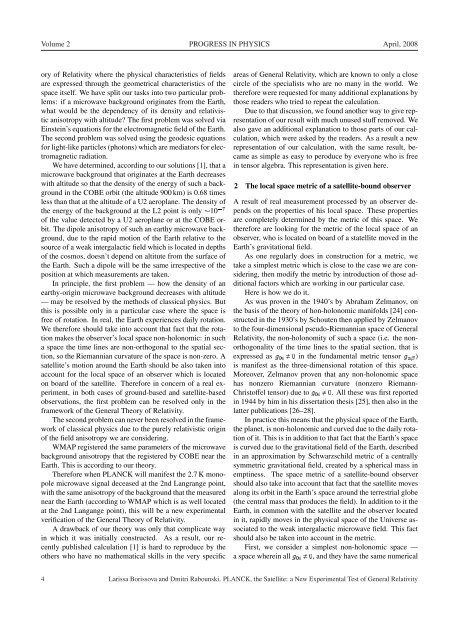Vol. 2 - The World of Mathematical Equations
Vol. 2 - The World of Mathematical Equations
Vol. 2 - The World of Mathematical Equations
You also want an ePaper? Increase the reach of your titles
YUMPU automatically turns print PDFs into web optimized ePapers that Google loves.
<strong>Vol</strong>ume 2 PROGRESS IN PHYSICS April, 2008ory <strong>of</strong> Relativity where the physical characteristics <strong>of</strong> fieldsare expressed through the geometrical characteristics <strong>of</strong> thespace itself. We have split our tasks into two particular problems:if a microwave background originates from the Earth,what would be the dependency <strong>of</strong> its density and relativisticanisotropy with altitude? <strong>The</strong> first problem was solved viaEinstein’s equations for the electromagnetic field <strong>of</strong> the Earth.<strong>The</strong> second problem was solved using the geodesic equationsfor light-like particles (photons) which are mediators for electromagneticradiation.We have determined, according to our solutions [1], that amicrowave background that originates at the Earth decreaseswith altitude so that the density <strong>of</strong> the energy <strong>of</strong> such a backgroundin the COBE orbit (the altitude 900 km) is 0.68 timesless than that at the altitude <strong>of</strong> a U2 aeroplane. <strong>The</strong> density <strong>of</strong>the energy <strong>of</strong> the background at the L2 point is only 10 7<strong>of</strong> the value detected by a U2 aeroplane or at the COBE orbit.<strong>The</strong> dipole anisotropy <strong>of</strong> such an earthy microwave background,due to the rapid motion <strong>of</strong> the Earth relative to thesource <strong>of</strong> a weak intergalactic field which is located in depths<strong>of</strong> the cosmos, doesn’t depend on altitute from the surface <strong>of</strong>the Earth. Such a dipole will be the same irrespective <strong>of</strong> theposition at which measurements are taken.In principle, the first problem — how the density <strong>of</strong> anearthy-origin microwave background decreases with altitude— may be resolved by the methods <strong>of</strong> classical physics. Butthis is possible only in a particular case where the space isfree <strong>of</strong> rotation. In real, the Earth experiences daily rotation.We therefore should take into account that fact that the rotationmakes the observer’s local space non-holonomic: in sucha space the time lines are non-orthogonal to the spatial section,so the Riemannian curvature <strong>of</strong> the space is non-zero. Asatellite’s motion around the Earth should be also taken intoaccount for the local space <strong>of</strong> an observer which is locatedon board <strong>of</strong> the satellite. <strong>The</strong>refore in concern <strong>of</strong> a real experiment,in both cases <strong>of</strong> ground-based and satellite-basedobservations, the first problem can be resolved only in theframework <strong>of</strong> the General <strong>The</strong>ory <strong>of</strong> Relativity.<strong>The</strong> second problem can never been resolved in the framework<strong>of</strong> classical physics due to the purely relativistic origin<strong>of</strong> the field anisotropy we are considering.WMAP registered the same parameters <strong>of</strong> the microwavebackground anisotropy that the registered by COBE near theEarth. This is according to our theory.<strong>The</strong>refore when PLANCK will manifest the 2.7 K monopolemicrowave signal deceased at the 2nd Langrange point,with the same anisotropy <strong>of</strong> the background that the measurednear the Earth (according to WMAP which is as well locatedat the 2nd Langange point), this will be a new experimentalverification <strong>of</strong> the General <strong>The</strong>ory <strong>of</strong> Relativity.A drawback <strong>of</strong> our theory was only that complicate wayin which it was initially constructed. As a result, our recentlypublished calculation [1] is hard to reproduce by theothers who have no mathematical skills in the very specificareas <strong>of</strong> General Relativity, which are known to only a closecircle <strong>of</strong> the specialists who are no many in the world. Wetherefore were requested for many additional explanations bythose readers who tried to repeat the calculation.Due to that discussion, we found another way to give representation<strong>of</strong> our result with much unused stuff removed. Wealso gave an additional explanation to those parts <strong>of</strong> our calculation,which were asked by the readers. As a result a newrepresentation <strong>of</strong> our calculation, with the same result, becameas simple as easy to peroduce by everyone who is freein tensor algebra. This representation is given here.2 <strong>The</strong> local space metric <strong>of</strong> a satellite-bound observerA result <strong>of</strong> real measurement processed by an observer dependson the properties <strong>of</strong> his local space. <strong>The</strong>se propertiesare completely determined by the metric <strong>of</strong> this space. Wetherefore are looking for the metric <strong>of</strong> the local space <strong>of</strong> anobserver, who is located on board <strong>of</strong> a statellite moved in theEarth’s gravitational field.As one regularly does in construction for a metric, wetake a simplest metric which is close to the case we are considering,then modify the metric by introduction <strong>of</strong> those additionalfactors which are working in our particular case.Here is how we do it.As was proven in the 1940’s by Abraham Zelmanov, onthe basis <strong>of</strong> the theory <strong>of</strong> hon-holonomic manifolds [24] constructedin the 1930’s by Schouten then applied by Zelmanovto the four-dimensional pseudo-Riemannian space <strong>of</strong> GeneralRelativity, the non-holonomity <strong>of</strong> such a space (i.e. the nonorthogonality<strong>of</strong> the time lines to the spatial section, that isexpressed as g 0i 0 in the fundamental metric tensor g )is manifest as the three-dimensional rotation <strong>of</strong> this space.Moreover, Zelmanov proven that any non-holonomic spacehas nonzero Riemannian curvature (nonzero Riemann-Christ<strong>of</strong>fel tensor) due to g 0i 0. All these was first reportedin 1944 by him in his dissertation thesis [25], then also in thelatter publications [26–28].In practice this means that the physical space <strong>of</strong> the Earth,the planet, is non-holonomic and curved due to the daily rotation<strong>of</strong> it. This is in addition to that fact that the Earth’s spaceis curved due to the gravitational field <strong>of</strong> the Earth, describedin an approximation by Schwarzschild metric <strong>of</strong> a centrallysymmetric gravitational field, created by a spherical mass inemptiness. <strong>The</strong> space metric <strong>of</strong> a satellite-bound observershould also take into account that fact that the satellite movesalong its orbit in the Earth’s space around the terrestrial globe(the central mass that produces the field). In addition to it theEarth, in common with the satellite and the observer locatedin it, rapidly moves in the physical space <strong>of</strong> the Universe associatedto the weak intergalactic microwave field. This factshould also be taken into account in the metric.First, we consider a simplest non-holonomic space —a space wherein all g 0i 0, and they have the same numerical4 Larissa Borissova and Dmitri Rabounski. PLANCK, the Satellite: a New Experimental Test <strong>of</strong> General Relativity
















